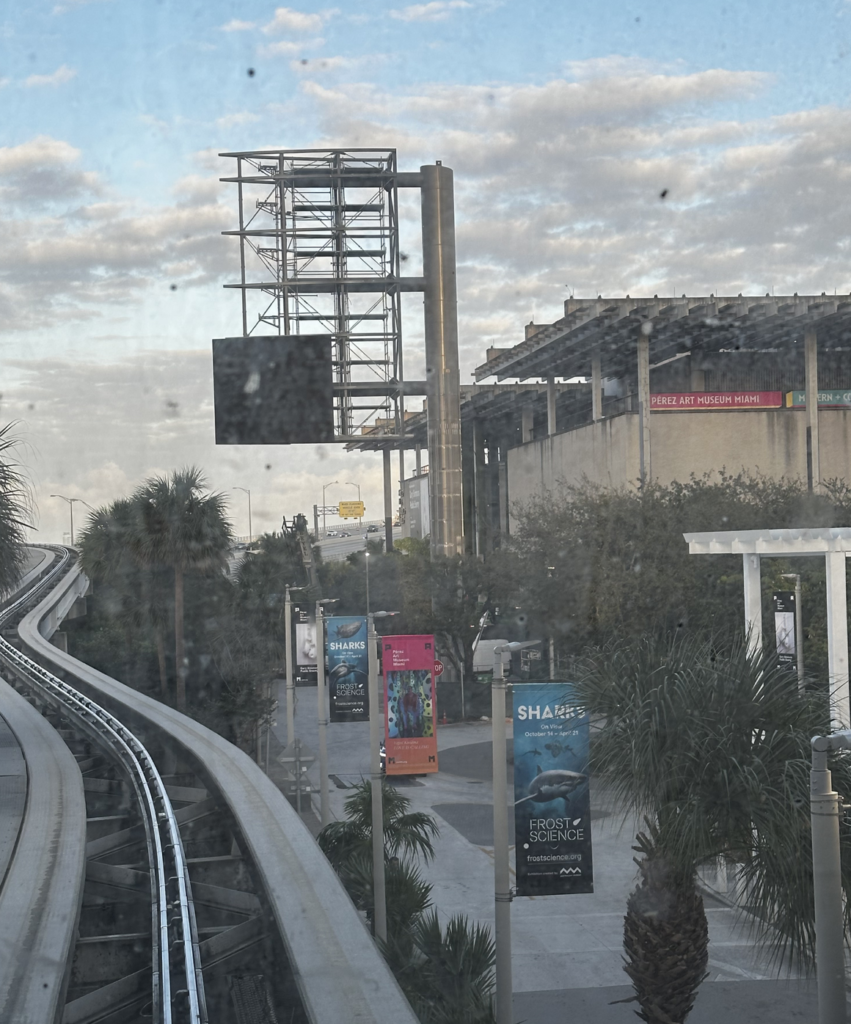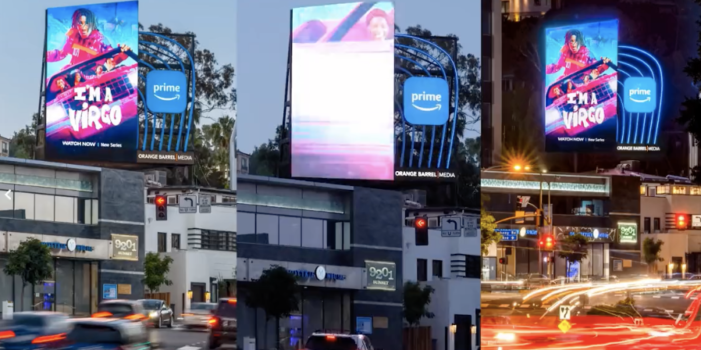Opponents claim the signs going up are illegal
Perhaps the third time is the charm for the repeal of the liberal digital billboard ordinance that allowed super huge LED signs on public land — like the one going up at the Perez Art Museum Miami. Miami City commissioners will discuss turning back the clock to the prior limits on signs — as well as a 240-day moratorium on providing new permits for them — at the commission meeting Thursday.
It’s been on the agenda twice already.
The first time it was deferred because commissioners wanted to get clarification from the state on their regulations. There was some question a to whether or not the billboards at PAMM and the Adrienne Arsht Performing Arts Center would be approved at the state level.
Earlier this month, on the second try, Commissioner Damian Pardo tabled the discussion because the meeting had gone long after a three-hour shade (out of the Sunshine) session with the city attorney on the redistricting lawsuit that the city is losing (more on that later).
“To start a dialogue on that issue when people were exhausted was not a good idea,” Pardo said.
Read related: Miami Commissioners defer decision on LED billboards in city parks
At the last meeting, like the first meeting, representatives of the PAMM and Arsht Center begged commissioners to carve them out of any repeal. They say that the digital signs won’t be facing or bothering the residents of the downtown high-rises facing their facilities.
“These are not the droids you are looking for,” said Evelyn Greer, a former mayor of Pinecrest and a board member of PAMM, quoting Obi Wan Kenobi of the Star Wars series. “We don’t shine into the neighbors,” Greer said. ” We want to talk to the tourists, the residents going to Miami Beach, the residents going back and forth.
“The sign faces the hundreds of thousands of people that go back and forth on I-395. it does not affect the neighbors here with genuine concerns about signs,” Greer stressed. “We are not that problem.”

There were some other people who spoke in favor, but they sounded scripted with the same “narrative” about the anti-sign “narrative” about downtown “vibrancy” and the signs being art. It was a little ironic.
PAMM people say they need the sign to raise funds, estimating somewhere between $1 million and $3 million a year. But that’s one of the things opponents say make it illegal.
Nathan Kurland, a longtime opponent of the signs, wrote a letter this week explaining the the signs the city has legalized are illegal because of the Miami-Dade County sign code.
“The Sign Code establishes minimum regulations for all outdoor signage, everywhere in the county. The county’s various municipalities may enact regulations for any type of sign more restrictive than the Sign Code requirements – Miami Beach, for example, prohibits Class C commercial billboards – but no city government legally may enact any rule more permissive than the Sign Code,” Kurland wrote.
Read related: LED billboards could buy their way to Miami streets via campaign donations
One of the rules is that these type of signs be for point of sale advertising only. So PAMM would have to sell tickets and trinkets from their gift store. Not the designer clothes and/or perfume that we’ve seen on some mock-ups. Another rule is that even if it is point of sale, the sign can only be placed on properties that are larger than 10 acres. Neither the PAMM nor the PAC reach that size.
“Therefore, your governmental duty in this regard is crystal-clear — kill the signs” Kurland said. “They are illegal.”
He is also upset with the lack of enforcement by the county.
“It is absolutely pathetic that, across the several decades during which the Miami City
Commission has ‘authorized’ or ‘approved’ the installation of scores of outdoor advertising
signs within its municipal boundaries – all in clear and absolute violation of the Sign Code, and
many of which persist to this day – that county officials could not be bothered to even lift a
finger to make a phone call and ask Miami officials to obey the law,” he wrote.
“The city of Miami’s flagrant violations of the governing statute – popularly known as “serial acts
of municipal prostitution,” given the many millions of dollars paid to the city in exchange for
obtaining those illegal ‘authorizations’ and ‘approvals’ – has simply been disgusting. And I believe the county shares equal blame with the city for that unconscionable history in our community.”
Opponents have also said that the sign ordinance providing for the larger sizes was passed when there was no commissioner on the dais for District 2, since Ken Russell had resigned to run for Congress and Sabina Covo had not yet been elected. They also point to contributions that Commissioner Alex Diaz de la Portilla received from another PAC operated by former Miami Commissioner Marc Sarnoff, a lobbyist for one of the digital sign companies and an outside counsel for the city of Miami, paid to represent the taxpayers in the Miami Freedom Park deal and the defense of Commissioner Joe Carollo in his federal civil rights trial.
Talk about a conflict of interest.
In fact, Billy Corben, a Miami activist and award-winning documentary filmmaker, said the ordinance had the same ingredients as the license agreement ADLP sponsored for The Centner Academy to get Biscayne Park, which has resulted in the commissioner being arrested and charged with 12 felonies, including bribery.
Could he have done the same thing again?
Letter against Illegal PAMM and Arsht Digital Signs February 2024 by Political Cortadito on Scribd

